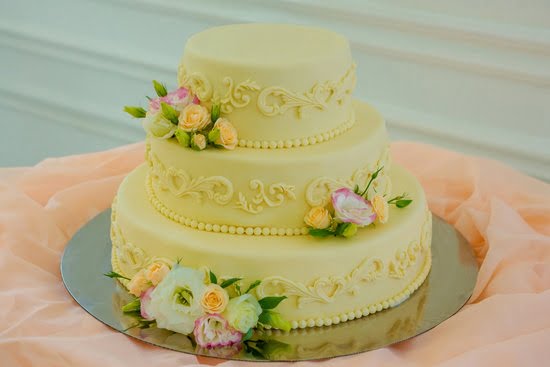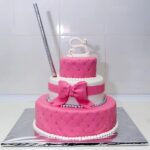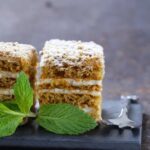Cake decorating wire is a versatile and essential tool for creating stunning and intricate cake designs. It adds depth, dimension, and creativity to cakes, allowing decorators to explore endless possibilities in their creations. Whether it’s delicate wire patterns or elaborate wire cake toppers, cake decorating wire brings a unique touch to any cake.
Cake decorating wire is an art form that involves shaping and bending different types of wires to create decorative elements for cakes. It can be used to make intricate floral arrangements, add embellishments and accents, or create structural components for tiered cakes. The addition of wire decorations elevates the overall design, bringing a sense of sophistication and elegance.
The importance of cake decorating wire cannot be overstated when it comes to creating unique and personalized cake designs. With the right techniques and tools, decorators can unleash their creativity by incorporating wire decorations into various themes and occasions. Whether it’s a wedding cake adorned with delicate wire patterns or a whimsical birthday cake featuring wire figurines, the possibilities are endless when using cake decorating wire.
In the following sections of this article, we will delve deeper into the world of cake decorating wire. We will explore the different types of wires available in the market and discuss their pros and cons.
We will also provide step-by-step instructions on how to securely attach wires to cakes and share tips on shaping and bending wires for different embellishments. Additionally, we will address safety precautions, troubleshooting tips, customer reviews, as well as inspiring ideas for incorporating wire decorations into your own creations.
So if you’re ready to take your cake designs to new heights and add that extra touch of creativity, join us as we dive into the art of cake decorating wire.
The Different Types of Cake Decorating Wire
Cake decorating wire comes in a variety of types, each offering unique advantages for creating stunning cake designs. Understanding the different types of wire available in the market and their suitability for various cake designs is crucial for cake decorators looking to elevate their creations.
1. Stainless Steel Wire:
Stainless steel wire is one of the most common types of cake decorating wire. It is sturdy and provides excellent support when creating intricate designs or adding structural elements to cakes. This type of wire is ideal for creating sculptures, tiered cakes, and gravity-defying designs. Its durability allows it to hold up well under the weight of fondant or heavy decorations.
2. Floral Wire:
Floral wire is another popular option in cake decorating. It is made from a flexible material (usually aluminum) that can be easily bent and shaped into various forms. Floral wire is often used to create delicate flower petals or branches, as it can mimic the natural curves and movements found in nature. It is also lightweight, making it suitable for delicate designs that require added flexibility.
3. Jewelry Wire:
Jewelry wire adds an elegant touch to cake designs, particularly when creating decorative patterns or accents. This type of wire is available in various colors and finishes, allowing decorators to match it with the overall theme or color scheme of the cake. Jewelry wire comes in different gauges, providing options for both subtle detailing and bolder statements.
While each type of cake decorating wire has its own advantages, there are a few considerations to keep in mind when choosing which one to use for a particular design. Stainless steel wire offers strength and stability but may require additional tools such as pliers or cutters for shaping purposes.
Floral wire provides flexibility but may not be suitable for heavier decorations due to its lightweight nature. Jewelry wire adds visual appeal but may not offer as much structural support as stainless steel or floral wires.
By understanding these differences, cake decorators can choose the type of wire that best suits their specific cake design needs. It is also important to practice and experiment with different types of wires to become familiar with their properties and how they interact with various cake decorating techniques.
Tools and Techniques for Cake Decorating with Wire
Cake decorating with wire requires certain tools and techniques to ensure a secure and visually appealing result. By utilizing the right tools and mastering specific techniques, cake decorators can create stunning wire embellishments that add depth and dimension to their designs.
One of the essential tools for cake decorating with wire is a pair of pliers. Pliers are used to shape and bend the wire according to the desired design. They come in different types, such as round-nose pliers for creating loops or flat-nose pliers for bending the wire at angles. Additionally, wire cutters are necessary for trimming the wire to the desired length.
To securely attach the wire to cakes, there are a few techniques that can be used. One common method is by inserting the end of the wire into a straw or floral tube filled with royal icing. The straw or tube acts as a support structure, ensuring that the wire stays in place without damaging the cake. Another technique involves using edible glue or gum paste adhesive to adhere small decorations made from wire directly onto the cake’s surface.
When shaping and bending wire, it is important to use caution and precision. Start with thin gauge wires, gradually increasing their thickness as needed for sturdier designs. To create loops or curves in the wire, gently wrap it around various cylindrical objects like paintbrush handles or dowels. For more intricate shapes, consider investing in shape cutters specifically designed for cake decorating.
It is crucial to note that safety precautions should be taken when working with cake decorating wire. Always ensure that your hands are clean and sanitize your tools before use. Avoid using rusty or damaged wires as they may contain harmful substances that could contaminate food. Additionally, make sure that any non-edible parts attached to the wire are securely wrapped or covered to prevent direct contact with food.
Table
| Essential Tools | Techniques |
|---|---|
| Pliers | Using straws or floral tubes to support the wire |
| Wire cutters | Using edible glue or gum paste adhesive |
| – | Cautious shaping and bending of wire |
Safety Precautions and Food Handling Regulations
Cake decorating wire adds a unique and intricate touch to cakes, but it is important to prioritize safety when using this decorative element. Adhering to food safety regulations is crucial to ensure that the wire does not contaminate the cake and cause any health issues. Here are some safety precautions and food handling regulations to keep in mind when using cake decorating wire:
- Compliance with Food Safety Standards: When using cake decorating wire, it is essential to comply with the food safety standards in your region or country. Familiarize yourself with the local regulations regarding edible decorations on cakes, as some jurisdictions may have specific guidelines or restrictions.
- Use Food-Grade Wire: To ensure safe use, it is recommended to choose food-grade wires for cake decorations. These wires are made specifically for food contact and are non-toxic. Stainless steel wires are often a popular choice for cake decorating because of their durability and resistance to rust.
- Proper Cleaning and Sterilizing: Before using any wire for cake decoration, it should be thoroughly cleaned and sterilized. This helps remove any dirt, debris, or contaminants that may be present on the wire’s surface. Use warm soapy water or a food-safe cleaning solution to clean the wire, followed by sterilization methods such as boiling or soaking in vinegar.
- Hygiene Practices: Maintaining proper hygiene practices while working with cake decorating wire is essential to prevent cross-contamination. Always wash your hands thoroughly before handling the wires or touching any part of the cake that will come into contact with the wire.
- Non-Edible Components: It is important to ensure that any non-edible components attached to the wire (such as beads or floral decorations) do not come into direct contact with the cake itself. These components should be securely attached to the wire but positioned in a way that keeps them separate from the areas that will be consumed.
By following these safety precautions and food handling regulations, you can enjoy the art of cake decorating with wire while ensuring the safety and well-being of those consuming the cake. Remember to always prioritize food safety and consult local guidelines for any specific regulations in your area.
Inspiring Wire Cake Decoration Ideas
Wire Cake Toppers
One of the most popular ways to incorporate wire decorations into cake designs is by creating stunning wire cake toppers. These toppers can range from simple figurines to elaborate structures that add a touch of elegance and uniqueness to any cake. For example, a wedding cake can be adorned with a delicate wire sculpture of a bride and groom, or a birthday cake can feature a wire decoration depicting the age being celebrated.
Floral Arrangements
Another creative way to use cake decorating wire is by incorporating it into floral arrangements on cakes. Using an assortment of colored wires, cake decorators can create realistic-looking flowers and leaves that can be securely attached to the cake’s surface. This technique allows for endless possibilities in terms of flower types, colors, and arrangements, making it a versatile choice for any occasion.
Intricate Wire Patterns
For those looking to add a touch of intricacy and sophistication to their cake designs, using wire to create patterns is an excellent option. By carefully bending and shaping the wire, decorators can achieve intricate designs such as lattices, spirals, or waves that add visual interest and depth. These wire patterns can be used as borders around the cake or incorporated into specific design elements.
Whether you’re aiming for a rustic charm with a wire-decorated country-style wedding cake or a modern twist with geometric wire patterns on your cupcakes, there are countless inspiring ideas for using cake decorating wire. Don’t be afraid to experiment and let your creativity run wild – with this versatile medium, the possibilities are truly endless.
Troubleshooting Common Issues with Cake Decorating Wire
Cake decorating wire can be a versatile and unique tool for creating intricate and beautiful cake designs. However, like any artistic medium, it comes with its own set of challenges and potential issues. In this section, we will address some common problems that may arise when using cake decorating wire and provide helpful troubleshooting tips to overcome them.
One common issue that decorators may encounter is wire breakage. When working with delicate or thin wires, the risk of breakage increases. To prevent this, it is important to choose a wire gauge that is appropriate for your design and the weight of the decorations. Thicker gauge wires are generally sturdier but may be more challenging to bend and shape.
If you find that your wire keeps breaking while bending or attaching it to the cake, try using pliers as leverage instead of using your hands alone. This will help distribute the pressure more evenly along the wire and minimize the risk of breakage. Additionally, consider annealing the wire by heating it gently with a flame before use. This process can make the wire more malleable and less prone to snapping.
Another issue that decorators may face is difficulty in attaching wire decorations securely to cakes. To ensure a secure attachment, start by inserting floral foam or other sturdy support structures into the cake where you plan to insert the wires. This provides stability and prevents the wires from sinking into the cake over time.
When inserting wires into cakes, always make sure they are clean and free from any residue or contaminants. It is also vital to sanitize your hands thoroughly before handling both the wire and the cake to maintain proper hygiene throughout the decoration process.
| Issue | Troubleshooting Tips |
|---|---|
| Wire Breakage | – Choose an appropriate wire gauge for your design\n – Use pliers as leverage when bending or shaping the wire\n – Consider annealing the wire before use |
| Difficulty in Attaching Wire Decorations | – Insert support structures into the cake for stability\n – Ensure clean and sanitized hands when handling wires and cakes |
By being aware of these common issues and implementing these troubleshooting tips, decorators can overcome challenges and achieve professional-looking results with cake decorating wire. With practice and creativity, cake decorators can elevate their designs to new heights using this unique medium.
Customer Reviews and Recommendations
When it comes to cake decorating, customer reviews and recommendations can be extremely valuable in helping decorators make informed decisions about which cake decorating wire to use. Hearing from others who have used a specific brand or type of wire can provide insight into its quality, durability, and ease of use. Additionally, personal anecdotes and success stories can help inspire and motivate decorators to try new techniques and designs.
Testimonials from Cake Decorators
Many cake decorators have shared their positive experiences with using cake decorating wire. For example, Jane Smith, a professional baker from New York City, raves about the versatility of stainless steel wire in her cake designs. She mentions that the wire is easy to work with, yet sturdy enough to hold heavier embellishments like sugar flowers or fondant shapes. Other decorators appreciate the flexibility of floral wire for creating delicate accents that add an elegant touch to their cakes.
One common theme among customer testimonials is the ability of cake decorating wire to elevate cake designs to new heights. Sarah Johnson, a home baker from Chicago, shares that using wire decorations allowed her to add intricate patterns and unique textures that truly made her cakes stand out at special events. Many decorators agree that incorporating wire into their designs has opened up a world of creative possibilities and elevated their work to a professional level.
Recommendations for Trusted Brands
Based on customer feedback and expert recommendations, several brands have gained recognition as trusted suppliers of high-quality cake decorating wire. “WireArt Cake Supplies” is frequently mentioned by decorators for their wide range of options and excellent customer service. Another popular brand is “CakeWire Pro,” known for their durable stainless steel wires that are perfect for supporting heavy decorations on tiered cakes.
It’s important to note that every decorator may have different preferences based on their individual needs and design styles. However, these recommended brands have consistently received positive feedback regarding their product quality and reliability.
By considering the experiences and recommendations of other cake decorators, bakers can make informed decisions about which cake decorating wire to choose. Whether it’s stainless steel wire for sturdy support or floral wire for delicate accents, hearing from others who have used the products can provide valuable insights. So, before embarking on your next cake decoration project, take advantage of customer reviews and recommendations to ensure that you’re selecting the best wire for your designs.
Conclusion
In conclusion, cake decorating wire is a versatile and essential tool for any cake decorator looking to take their designs to the next level. It allows for the creation of intricate patterns, adds depth and dimension to cakes, and opens up endless possibilities for creative embellishments. By incorporating wire decorations into your cakes, you can truly elevate your designs and make them stand out.
Throughout this article, we have discussed the different types of cake decorating wire available in the market, including stainless steel, floral wire, and jewelry wire. Each type has its own advantages and suitability for different cake designs. We have also explored the tools and techniques needed for working with cake decorating wire, as well as precautions to ensure food safety and hygiene.
In addition, we showcased inspiring cake designs that incorporate wire decorations, providing readers with creative ideas for different themes and occasions. Customer reviews and recommendations from experienced cake decorators further validate the effectiveness of using cake decorating wire in achieving professional-looking results.
So, whether you are a novice or an experienced cake decorator, don’t be afraid to experiment with cake decorating wire. Let your creativity flow and explore the endless possibilities that wire decorations can bring to your cakes. Elevate your designs, add that extra touch of sophistication or playfulness, and create cakes that will wow your clients or guests.
Share your own experiences with wire cake decoration or reach out if you have any remaining questions. With cake decorating wire in hand, the only limit is your imagination.
Frequently Asked Questions
What wire to use for cake decorations?
When it comes to cake decorations, it is important to use the right kind of wire that is safe for food contact. The most commonly recommended wire for cake decorations is floral wire, specifically the types made from stainless steel or aluminum. These wires are thin and flexible, making them ideal for creating delicate designs and figures on cakes.
It is also important to ensure that the wire used is clean and sterilized before inserting it into the cake. Using appropriate cake decorating wire will not only help in achieving beautiful designs but also ensure that it does not pose any health risks.
Can you put florist wire in a cake?
While florist wire is often used for various decorative purposes, caution must be exercised when deciding whether or not to place it directly into a cake. Not all florist wires are designed with food safety in mind and may not be suitable for direct contact with edible items.
Some floral wires may contain coatings or materials that are not intended for consumption and could introduce contaminants into the cake. Therefore, unless you can confirm that the specific florist wire you have is explicitly labeled as food-safe and meets relevant safety standards, it is generally recommended to avoid putting florist wire directly into a cake.
Is Florist wire food safe?
Florist wire itself is not inherently food safe as its primary purpose lies outside of culinary applications. The use of certain types of florist wire in direct contact with food can introduce potential hazards. Regular florist wires may be coated with various substances such as paint, lacquer, or chemicals that are intended for decorative purposes rather than consumption.
These coatings could potentially leach harmful substances into the food, compromising its safety when consumed. To ensure food safety, always opt for floral wires specifically designed and marketed as food-safe or suitable for edible uses when aiming to incorporate wire decorations into cakes or other edible creations

Welcome to our cake decorating blog! My name is Destiny Flores, and I am the proud owner of a cake decorating business named Cake Karma. Our mission is to provide delicious, beautiful cakes for all occasions. We specialize in creating custom cakes that are tailored specifically to each customer’s individual needs and tastes.





